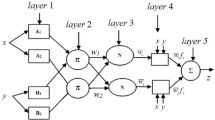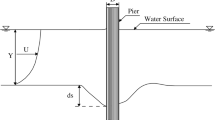Abstract
Block ramps are among the environmentally friendly hydraulic structures used for energy dissipation in rivers and waterways. Modeling the energy dissipation on these structures is ever-challenging in hydraulic engineering. The primary goal of the current study is to propose a novel metaheuristic-based artificial intelligence (AI) framework for energy dissipation prediction on block ramp structures. An improved African Vultures Optimization Algorithm (AVOA) is used to optimize the Adaptive Neuro-Fuzzy Inference System (ANFIS) in this investigation for accurate prediction of the energy dissipation on the block ramps. The performance of the hybrid ANFIS-IAVOA model is compared with an ANFIS and its hybrid versions using original AVOA, honey badger algorithm (ANFIS-HBA), grey wolf optimizer (ANFIS-GWO), monarch butterfly optimization (ANFIS-MBO), and black widow optimization (ANFIS-BWO) models. A dataset of 210 experiments measured at Shahid Chamran University of Ahvaz and 241 experiments collected from literature are used to construct the proposed hybrid models. The results demonstrate the better efficiency of hybrid ANFIS-IAVOA with RMSE of 0.018–0.020 and R2 of 0.98–0.98 compared to ANFIS-AVOA (RMSE ~ 0.023–0.25 and R2 ~ 0.97–0.97), ANFIS-HBA (RMSE ~ 0.021–0.025 and R2 ~ 0.97–0.97), ANFIS-MBO (RMSE ~ 0.022–0.023 and R2 ~ 0.97–0.97), ANFIS-GWO (RMSE ~ 0.022–0.024 and R2 ~ 0.97–0.97), ANFIS-BWO (RMSE ~ 0.027–0.028 and R2 ~ 0.96–0.96), and ANFIS (RMSE ~ 0.029–0.033 and R2 ~ 0.954 − 0.951). The statistical measures show that the proposed ANFIS-IAVOA performs better than the other metaheuristic-based and standalone ANFIS-developed models. The impressiveness of the proposed hybrid model demonstrates that it can be used for further investigations on the probabilistic assessment of the block ramp hydraulic structures.











Similar content being viewed by others
Data Availability
The data presented in this study are available on request from the corresponding author.
References
Abdollahzadeh B, Gharehchopogh FS, Mirjalili S (2021) African vultures optimization algorithm: a new nature-inspired metaheuristic algorithm for global optimization problems. Comput Ind Eng 158:107408
Abdollahzadeh B, Soleimanian Gharehchopogh F, Mirjalili S (2021) Artificial gorilla troops optimizer: a new nature-inspired metaheuristic algorithm for global optimization problems. Int J Intell Syst 36:5887–5958
Aberle J, Smart GM (2003) The influence of roughness structure on flow resistance on steep slopes. J Hydraul Res 41:259–269
Ahmad Z, Petappa NM, Westrich B (2009) Energy dissipation on block ramps with staggered boulders. J Hydraul Eng 135:522–526
Ahmad Z, Srisvastava D (2014) Energy dissipation on block ramps with large scale roughness. In: ISHS 2014-hydraulic structures and society-engineering challenges and extremes: Proceedings of the 5th IAHR International Symposium on Hydraulic Structures. The University of Queensland, pp 1–8
Arya Azar N, Ghordoyee Milan S, Kayhomayoon Z (2021) The prediction of longitudinal dispersion coefficient in natural streams using LS-SVM and ANFIS optimized by Harris hawk optimization algorithm. J Contam Hydrol 240:103781. https://doi.org/10.1016/j.jconhyd.2021.103781
Ben Seghier MEA, Corriea JAFO, Jafari-Asl J et al (2021) On the modeling of the annual corrosion rate in main cables of suspension bridges using combined soft computing model and a novel nature-inspired algorithm. Neural Comput Appl 2021 3323 33:15969–15985. https://doi.org/10.1007/S00521-021-06199-W
Ben Seghier MEA, Golafshani EM, Jafari-Asl J, Arashpour M (2023) Metaheuristic-based machine learning modeling of the compressive strength of concrete containing waste glass. Struct Concr. https://doi.org/10.1002/suco.202200260
Cui F, Al-Sudani ZA, Hassan GS et al (2022) Boosted artificial intelligence model using improved alpha-guided grey wolf optimizer for groundwater level prediction: comparative study and insight for federated learning technology. J Hydrol 606:127384
Fan J, Li Y, Wang T (2021) An improved african vultures optimization algorithm based on tent chaotic mapping and time-varying mechanism. PLoS ONE 16:e0260725
Ferro V (1999) Friction factor for gravel-bed channel with high boulder concentration. J Hydraul Eng 125:771–778
Ghare AD, Ingle RN, Porey PD, Gokhale SS (2010) Block ramp design for efficient energy dissipation. J Energy Eng 136:1–5
Hashim FA, Houssein EH, Hussain K et al (2022) Honey badger algorithm: new metaheuristic algorithm for solving optimization problems. Math Comput Simul 192:84–110
Hayyolalam V, Kazem AAP (2020) Black widow optimization algorithm: a novel meta-heuristic approach for solving engineering optimization problems. Eng Appl Artif Intell 87:103249
Ibrahim KSMH, Huang YF, Ahmed AN et al (2022) Forecasting multi-step-ahead reservoir monthly and daily inflow using machine learning models based on different scenarios. Appl Intell 1–24
Jang J-S (1993) ANFIS: adaptive-network-based fuzzy inference system. IEEE Trans Syst Man Cybern 23:665–685
Jutury D, Kumar N, Sachan A et al (2023) Adaptive neuro-fuzzy enabled multi-mode traffic light control system for urban transport network. Appl Intell 53:7132–7153
Khatibi R, Salmasi F, Ghorbani MA, Asadi H (2014) Modelling energy dissipation over stepped-gabion weirs by artificial intelligence. Water Resour Manag 28:1807–1821. https://doi.org/10.1007/s11269-014-0545-y
Kim S, Salmasi F, Ghorbani MA et al (2021) Energy Dissipation in Rough Chute: Experimental Approach Versus Artificial Intelligence Modeling. Intell Data Anal Decis Syst Hazard Mitig Theory Pract Hazard Mitig 227–249
Kothyari UC, Hayashi K, Hashimoto H (2009) Drag coefficient of unsubmerged rigid vegetation stems in open channel flows. J Hydraul Res 47:691–699
Mahdavi-Meymand A, Sulisz W, Zounemat-Kermani M (2022) A comprehensive study on the application of firefly algorithm in prediction of energy dissipation on block ramps. Eksploat i Niezawodn 24. https://doi.org/10.17531/ein.2022.2.2
Mai SH, Ben Seghier MEA, Nguyen PL et al (2022) A hybrid model for predicting the axial compression capacity of square concrete-filled steel tubular columns. Eng Comput 38:1205–1222. https://doi.org/10.1007/s00366-020-01104-w
Mirjalili S, Mirjalili SM, Lewis A (2014) Grey wolf optimizer. Adv Eng Softw 69:46–61. https://doi.org/10.1016/J.ADVENGSOFT.2013.12.007
Novák P, Čabelka J (1981) Models in Hydraulic Engineering: Physical Principles and Design Applications. Monographs & surveys in water resources engineering
Oertel M, Peterseim S, Schlenkhoff A (2011) Drag coefficients of boulders on a block ramp due to interaction processes. J Hydraul Res 49:372–377. https://doi.org/10.1080/00221686.2011.565695
Ohadi S, Hashemi Monfared SA, Azhdary Moghaddam M, Givehchi M (2023) Feasibility of a novel predictive model based on multilayer perceptron optimized with Harris hawk optimization for estimating of the longitudinal dispersion coefficient in rivers. Neural Comput Appl 35:7081–7105. https://doi.org/10.1007/s00521-022-08074-8
Pagliara S, Chiavaccini P (2006) Energy dissipation on block ramps. J Hydraul Eng 132:41–48. https://doi.org/10.1061/(ASCE)07339429(2006)132:1(41)
Pagliara S, Palermo M, Lotti I (2009) Sediment transport on block ramp: filling and energy recovery. KSCE J Civ Eng 13:129–136. https://doi.org/10.1007/s12205-009-0129-1
Pagliara S, Palermo M, Roy D (2020) Experimental investigation of erosion processes downstream of block ramps in mild curved channels. Environ Fluid Mech 20:339–356. https://doi.org/10.1007/s10652-019-09681-1
Rad MJG, Ohadi S, Jafari-Asl J et al (2022) GNDO-SVR: an efficient surrogate modeling approach for reliability-based design optimization of concrete dams. Structures 35:722–733. https://doi.org/10.1016/j.istruc.2021.11.048
Rahmanshahi M, Shafai Bejestan M (2020) Gene-expression programming approach for development of a mathematical model of energy dissipation on block ramps. J Irrig Drain Eng 146:4019033. https://doi.org/10.1061/(ASCE)IR.1943-4774.0001442
Salmasi F, Sattari MT, Nurcheshmeh M (2021) Genetic programming approach for estimating energy dissipation of flow over cascade spillways. Iran J Sci Technol Trans Civ Eng 45:443–455. https://doi.org/10.1007/s40996-020-00541-3
Tamagni S, Weitbrecht V, Boes RM (2014) Experimental study on the flow characteristics of unstructured block ramps. J Hydraul Res 52:600–613. https://doi.org/10.1080/00221686.2014.950610
Wang Z, Ma G, Gong D et al (2019) Application of mind evolutionary algorithm and artificial neural networks for prediction of profile and flatness in hot strip rolling process. Neural Process Lett 2019 503 50:2455–2479. https://doi.org/10.1007/S11063-019-10021-Z
Weitbrecht V, Tamagni S, Boes RM (2017) Stability of unstructured block ramps. J Hydraul Eng 143:4016095. https://doi.org/10.1061/(ASCE)HY.1943-7900.0001259
Author information
Authors and Affiliations
Corresponding author
Ethics declarations
Ethics Approval
All work complies with Ethical Standards.
Consent to Participate
All authors confirm their co-authorship.
Consent to Publish
The authors give their permission to publish.
Conflict of Interest
The authors declare that they have no competing interests.
Additional information
Publisher’s Note
Springer Nature remains neutral with regard to jurisdictional claims in published maps and institutional affiliations.
Rights and permissions
Springer Nature or its licensor (e.g. a society or other partner) holds exclusive rights to this article under a publishing agreement with the author(s) or other rightsholder(s); author self-archiving of the accepted manuscript version of this article is solely governed by the terms of such publishing agreement and applicable law.
About this article
Cite this article
Rahmanshahi, M., Jafari-Asl, J., Shafai Bejestan, M. et al. A Hybrid Model for Predicting the Energy Dissipation on the Block Ramp Hydraulic Structures. Water Resour Manage 37, 3187–3209 (2023). https://doi.org/10.1007/s11269-023-03497-x
Received:
Accepted:
Published:
Issue Date:
DOI: https://doi.org/10.1007/s11269-023-03497-x




